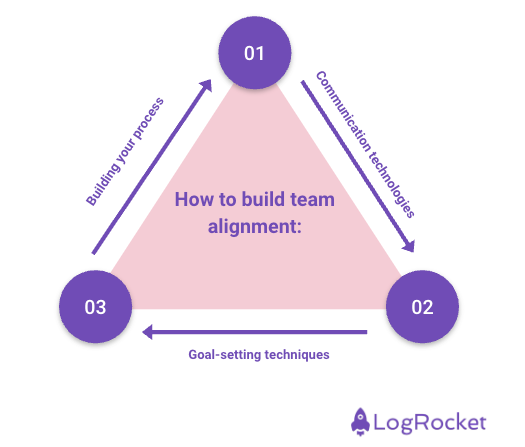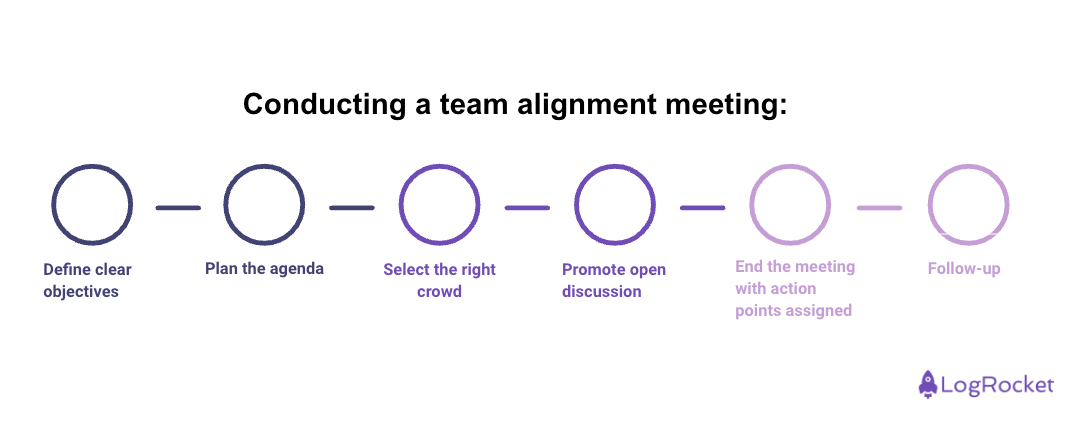Whenever I’m upset with my team and feel like I could just ditch them and do things on my own, I hear Velma Kelly from the hit musical “Chicago” signing “I can’t do it alone” in my head as a reminder. Then, I realize that whatever my problem with the development team is, it’s most likely coming from me alone and I simply need to do better.

Perhaps I wrote a poor ticket. Maybe I described the challenge in a murky way. Maybe I didn’t have enough time to ensure that the end result would follow my vision.
All that can be achieved when the team understands the product manager perfectly and the PM has a full grasp of the team’s limits and possibilities. This happens when you achieve team alignment. In this article, you’ll learn more about what team alignment means, how you can build it, and some of the challenges you might face along the way.
Team alignment is a state where product/development team members understand, agree upon, and are committed to achieving clearly defined goals. It involves ensuring that everyone’s working towards the same objectives with a shared understanding of their roles, responsibilities, the processes they need to follow, as well as how the final outcome should work, look, and feel.
Successful aliment results in:
Now, let’s look at some strategies and best practices to ensure your team is aligned and working effectively. The three most important categories are:

Remember, building alignment is an ongoing process that requires continuous attention and effort. You should be able to easily sustain a collaborative, transparent, and high-performing agile scrum team by implementing these strategies and best practices.
Organizing and conducting an effective team alignment meeting is essential for ensuring that everyone on the team is on the same page. To make the team alignment meetings effective, follow these steps:

Before the meeting, establish what you want to achieve. Not all meetings will follow the same structure. Once you can focus on goals, other times on strategy or make a follow-up to a recent retrospective where a major lack of alignment was discovered.
Make sure specific topics are timeboxed and the meeting is moderated. Just talking and talking about alignment won’t help to introduce it. You need to get the room to agree on something and quickly! Make sure to share the agenda and goals before it starts.
Jeff Bezos once said that in order for the meeting to be effective, you should be able to feed the participants with two pizzas. While for alignment purposes you might need more, make sure all the right people are invited. It’s not a complete, successful alignment if key team members are missing to save corporate funds on pizza!
Despite moderation, encourage open and honest discussions. People need to feel empowered to speak up and express their concerns. It might be that some levels of frustrations will have to be discharged before a true alignment can be achieved.
Your alignment (kick start) meetings won’t make any sense if they don’t conclude with a set of action items assigned to owners and deadlines. Make sure to document the action plan and use a system that’ll allow you to track progress.
You can either issue a progress review meeting or simply review it during the next team alignment meeting.
Achieving team alignment can be challenging, but understanding the typical hurdles and implementing solutions can help the alignment quickly return on the right tracks. Here are some common challenges and proposed solutions:
For me, the biggest alignment story I can tell is the story of my first team as a product owner. Back then I didn’t have much product experience. I came from a project management background and I really didn’t know how to unite people around me to create great products. That obviously was a downside when it came to actually working with the team who, on top of my lack of experience, also had bad dealings with their previous product manager.
I had to literally face doubt and opposition against any idea I would bring to the table. Nothing was good enough and nothing was worth doing. However, in time I started presenting my team with a very detailed account of what I wanted to do and why.
I spent multiple meetings showing them my longtime vision, my ideas, how to achieve them, and welcoming the team to accompany me and propose ideas at every step. I think the breakthrough came when I showed up to a meeting with them with a prioritized backlog that they hated. So rather than quarrel with them I challenged them to reprioritize the backlog with me.
We worked for an hour together selecting every task, its value, its complexity, and the risks associated. Surprisingly at the end of the session, we achieved the exact same prioritization that I had proposed the moment I walked into the room. From that day, everything that I brought to the team was received with a lot of goodwill and trust. However I didn’t end there and I kept on involving them at every possible step and treating them as partners rather than developers working for me.
I started by saying that as a PM, you can’t do it alone. You can’t be successful without a supporting team that understands your motivations, goals, and trusts that you’re setting them on a path to build a great product.
Without team alignment, this level of loyalty will simply never happen. That’s why being on the same page is so important and why you should aim to transform your team of product code developers into a team of eager and proactive “junior product managers.”
Thank you for reading and I hope to see you soon in my next post!
Featured image source: IconScout

LogRocket identifies friction points in the user experience so you can make informed decisions about product and design changes that must happen to hit your goals.
With LogRocket, you can understand the scope of the issues affecting your product and prioritize the changes that need to be made. LogRocket simplifies workflows by allowing Engineering, Product, UX, and Design teams to work from the same data as you, eliminating any confusion about what needs to be done.
Get your teams on the same page — try LogRocket today.

A practical framework for PMs to use AI in ideation without sacrificing judgment, strategy, or decision quality.

A practical five minute revenue estimation method to help product managers compare ideas, drop low impact features, and prioritize smarter.

A practical guide for PMs who want to stop being bottlenecks, delegate smarter, and lead teams effectively with a clear ownership framework.

Stop letting unreliable data block features. Treat data as inventory to track quality, ownership, and ship with confidence.